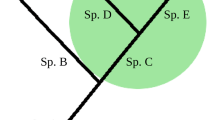Abstract
The genetic electrophoretic variation at up to 43 protein loci was studied in four hominoid, three cercopithecoid, and three ceboid species. Phylogenetic reconstructions based on genetic distances show that the two chimpanzee species are closest to humans, while the gorilla diverged earlier than the split between humans and the chimpanzee. Within the cercopithecoids the green monkey apparently diverged earlier than the macaques, and within the ceboids, the owl monkey is only distantly related to the capuchin and squirrel monkeys. The hypothesis that rates of evolution at the level of protein electrophoretic variation are equal both among the groups, as well as within each group, could not be rejected.
Similar content being viewed by others
References
Andrews, P., 1986. Fossil evidence on human origins and dispersal.Cold Spring Harbor Symp. Quant. Biol., 60: 419–428.
Ayala, F. J., 1980. Genetic and evolutionary relationships of apes and humans. In:Evolution of Social Behavior: Hypotheses and Empirical Tests,H. Markl (ed.), Verlag Chemie, Weinheim, pp. 147–162.
Bianchi, N. O., M. S. Bianchi, J. E. Cleaver, &S. Wolff, 1985. The pattern of restriction enzyme-induced banding in the chromosomes of chimpanzee, gorilla, and orangutan and its evolutionary significance.J. Mol. Evol., 22: 323–333.
Bruce, E. J. &E. J. Ayala, 1979. Phylogenetic relationship between man and the apes: electrophoretic evidence.Evolution, 33: 1040–1056.
Chiarelli, A. B., 1973.Evolution of the Primates. An Introduction to the Biology of Man. Academic Press, London.
de Jong, W. W. &M. Goodman, 1988. Anthropoid affinities ofTarsius supported by lensαA-crystallin sequences.J. Human Evol., 17: 575–582.
Goodman, M. &G. W. Lasker, 1975. Molecular evidence as to man's place in nature. In:Primate Functional Morphology and Evolution,R. H. Tuttle (ed.), Mouton, The Hague, pp. 89–101.
————,G. Braunitzer, A. Stangl, &B. Schrank, 1983. Evidence on human origins from haemoglobins of African apes.Nature, 303: 546–548.
Graur, D., 1986. The evolution of electrophoretic mobility of proteins.J. Theor. Biol., 118: 443–469.
Harris, H. &D. A. Hopkinson, 1976.Handbook of Enzyme Electrophoresis in Human Genetics. North-Holland, Amsterdam.
Hasegawa, M., H. Kishino, &T. Yano, 1987. Man's place in Hominoidea as inferred from molecular clocks of DNA.J. Mol. Evol., 26: 132–147.
Hayasaka, K., T. Gojobori, &S. Horai, 1988. Molecular phylogeny and evolution of primate mitochondrial DNA.Mol. Biol. Evol., 5: 626–644.
Hillis, D. M., 1984. Misuse and modification of Nei's genetic distance.Syst. Zool., 33: 238–240.
King, M.-C. &A. C. Wilson, 1975. Evolution at two levels in humans and chimpanzees.Science, 188: 107–116.
Koop, B. F., M. Goodman, P. Xu, K. Chan, &J. L. Slightom, 1986. Primateη-globin DNA sequences and man's place among the great apes: genealogical relations and classification.Proc. Natl. Acad. Sci., U.S.A., 85: 7627–7631.
Li, W.-H. &M. Tanimura, 1987. The molecular clock runs more slowly in man than in apes and monkeys.Nature, 326: 93–96.
Miyamoto, M. M., B. F. Koop, J. L. Slightom, M. Goodman, &M. R. Tennanat, 1988. Molecular systematics in higher primates.Proc. Nat. Acad. Sci., U.S.A., 85: 7627–7631.
Nei, M., 1972. Genetic distances between populations.Amer. Naturalist, 106: 283–292.
———— &A. K. Roychoudhury, 1974. Sampling variances of heterozygosity and genetic distances.Genetics, 76: 379–390.
Nozawa, K., T. Shotake, Y. Ohkura, &Y. Tanabe, 1977. Genetic variations within and between species of Asian macaques.Japan. J. Genet., 52: 15–30.
Oxnard, O. E., 1981. The place of man among primates: anatomical, molecular and morphometric evidence.Homo, 32: 149–176.
Sarich, V. M. &J. E. Cronin, 1976. Molecular systematics of the primates. In:Molecular Anthropology. Genes and Proteins in the Evolutionary Ascent of Primates,M. Goodman &R. E. Tashian (eds.), Plenum, New York, pp. 141–170.
Sibely, C. G. &J. E. Ahlquist, 1984. The phylogeny of the hominoid primates, as indicated by DNA-DNA hybridization.J. Mol. Evol., 20: 2–15.
———— & ————, 1987. DNA hybridization evidence of hominoid phylogeny: results from an expanded data set.J. Mol. Evol., 26: 99–121.
Sneath, P. H. A. &R. R. Sokal, 1973.Numerical Taxonomy. Freeman, San Francisco.
Tetushkin, E. Y., 1981. Genetic distance between the taxa of primates.Doklady Akademii Nauk SSSR., 256: 717–722.
Tomiuk, J. &D. Graur, 1988. Nei's modified genetic identity and distance measures and their sampling variances.Syst. Zool., 37: 156–162.
Tuttle, R., 1975. Parallelism, brachiation and hominoid phylogeny. In:Phylogeny of the Primates. A Multidisciplinary Approach,W. P. Luckett &F. S. Szalay (eds.), Plenum, New York, pp. 447–480.
Author information
Authors and Affiliations
About this article
Cite this article
Schmitt, J., Graur, D. & Tomiuk, J. Phylogenetic relationships and rates of evolution in primates: Allozymic data from catarrhine and platyrrhine species. Primates 31, 95–108 (1990). https://doi.org/10.1007/BF02381032
Received:
Accepted:
Issue Date:
DOI: https://doi.org/10.1007/BF02381032




